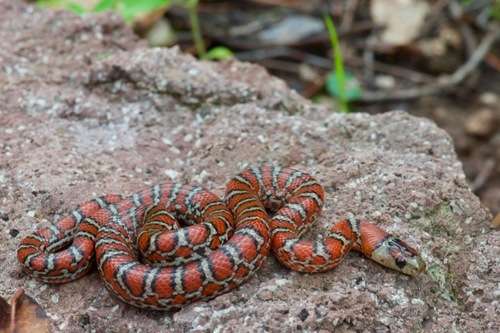
Description:
Scientific name: Lampropeltis pyromelana knoblochi
Life span: 12-20 years
The western United States and northern Mexico are home to the non-venomous California kingsnake. The California kingsnake is one of the most well-liked snakes kept in captivity because of how easy it is to care for them and the variety of colors they come in. These snakes typically have whitish-yellow streaks running across their dark brown or black bodies. The moniker “king” relates to their proclivity to hunt and consume other snakes, notably dangerous rattlesnakes that are often native to their natural habitat.

Native Region/Habitat
The Tehachapi Mountains and the southeasterly Sierra Nevada Mountains are only two of the many locations in North America’s West Coast where California kingsnakes can be found. Oregon, California, Nevada, Utah, Arizona, and the northwest of Mexico are all home to these snakes. They can be found residing in a wide range of habitats, such as woodland chaparral, grassland, deserts, marshes, river bottoms, and even residential areas.
Behavior:
California When compared to snakes of a similar size, kingsnakes are rather calm, but they are often tense. They usually won’t turn hostile until they are disturbed. Hissing, curling into a ball, and rapidly vibrating the tail are indications that your California King is under stress (like a rattlesnake).
Although California kingsnakes are primarily diurnal, they may start to spend more time at night during especially hot spells. Although they tend to be terrestrial, they can climb low branches and bushes. Except when they hibernate in the winter, they are typically loners. They withdraw underground during the winter and go into a state resembling hibernation known as brumation.
Care As a pet/In captivity:
Escape-proof cages should have a hiding spot and water. Because they are cannibalistic, kingsnakes and milk snakes must be housed separately (unless during breeding season). If ventilation holes are made in the sidewalls of inexpensive enclosures like plastic shoe or sweater boxes, they function well. If you want to display the snake, aquariums or homemade cages also work nicely. To keep the animals clean, warm, and dry, a variety of substrates (such as aspen shavings, rodent bedding made from corn cobs, or newspaper) may be utilized. Any kind of food will be enough for king snakes to eat. They will eat both warm-blooded and cold-blooded species, such as lizards and frogs, as well as warm-blooded prey like rodents and birds (in addition to other snakes). If kept between 80 and 85 degrees Fahrenheit with a five to ten degree dip at night, many species adapt well to life in captivity. Temperature regulation is crucial because it preserves digestion and feeding response.
Table





